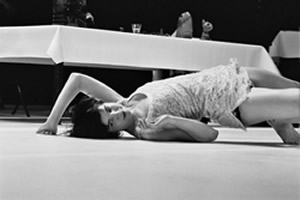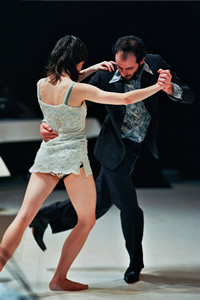
Choose Your Poison
By Martin Harries
Isabella's Room
By Jan Lauwers and Needcompany
Brooklyn Academy of Music
(closed)
Those Belgians, how they confound all our
categories! Two centuries of horrific historical responsibility
and damage weigh like a nightmare on the brains of the living,
and yet Belgians have brought New York the most exhilarating,
captivating, and exuberantly unashamed performances of the past
several years. It seems they no longer wear sackcloth in the drab
cafés of their sepulchral capitals. Here they are, dashing in
revealing clothes before the eyes of Brooklyn audiences notorious
for being buttoned up to our necks in black. What can they be
thinking? We hold on to our hats and our turtlenecks.
Call it an accident of my quirky viewing:
Anna Teresa De Keersmaeker's Drumming struck me as the
first work of art that made any sense at all in the fall of 2001.
Drumming's geometrical arrangement of dancers kept time
with Steve Reich's music; its joyful refusal of the blandishments
and stratagems of narrative was welcome in that grim season. De
Keersmaeker's Rain, in 2003, was almost as terrific,
as constantly engaging, as ravishing. And in December, Needcompany,
from Flanders -- where this crowd of freakishly talented and gorgeous
people are supported by the National Lottery! -- brought Isabella's
Room, a great mess of a dance-theater piece which dealt with
the historical wreckage Drumming and Rain acknowledged
in silence.
Isabella's Room takes on the European
twentieth century head-on. It faces Belgium's colonial past, World
War II, and the dilemma of so-called humanitarian interventions
in contemporary Africa. As the director, Jan Lauwers, explains
in a spoken introduction, a collection of ethnological objects
left to Lauwers by his father inspired the piece. Around these
objects Lauwers and his company built a performance that combines,
but does not integrate, dialogue, direct address, dance, songs,
and recorded music. These elements tell the story of blind, vivacious,
haunted Isabella (Viviane De Muynck), moving from her tumultuous
childhood on an unnamed island, to Paris (where she inherits the
collection of objects and becomes an anthropologist), to Africa.
Told in idiosyncratic fragments -- Ludde Hagberg narrates and
two dancers, Tijen Lawton and Louise Peterhoff, play the two sides
of Isabella's brain while the passage of whole horrific years
(1942, 1943) is indicated merely as a jarring percussive noise
Lawton produces by jabbing a piece of electronic gear -- this
narration has the virtue of being entirely implausible.
The narrative implausibility points to
large questions: Isabella's Room is a violent fairy tale
of European modernity. It even has a "Desert Prince," the name
Isabella's parents concoct to conceal her true paternity. The
production, however, draws attention to the divergence between
the fantastic "plot" and the bodies performing it. For my part,
I recall the dancing of the bearded Julien Faure, the
performer who plays the supposed Prince, more vividly than the
narrative myth-making surrounding him.
This might seem a backhanded compliment:
an overly ambitious story vanishes behind the bodies of the performers
who perform it. Some of the narrative elements -- especially the
story, late in the piece, about Isabella's much younger lover's
disastrous relief expedition in Africa -- do seem simply strained.
But strain between narrative and performers, history and bodies,
is at the heart of the action. Instead of an elegant dramatic
narrative in which performers vanish into their roles, Isabella's
Room stages a tension between bodies and narrative.
 A
few moments illustrate this tension especially well. Near the
beginning, Benoît Gob, who plays Isabella's father, moves from
acting in more or less the usual sense -- he is "inside" a scene
-- into an extended, sinuous, double-jointed moonwalk of a dance
that comes as a surprise from his chunky body. I would guess that
no one could have danced that dance in the period and place of
the dramatic action, which is somewhere in France near the beginning
of the last century. Later, Louise Peterhoff, as "Sister Joy,"
twice comes center-stage to perform a kind of hyperbolic leap
like an ecstatic butterfly confined to one spot, or like a hopping
sprite almost ready to take off. At another point, Peterhoff gallops
half-naked across the stage with her shirt pulled over her head
in a strange image of frustration and exuberance. At still another,
a group of performers lift the terrific Anneke Bonnema over their
heads as she sings one of the production's songs.
A
few moments illustrate this tension especially well. Near the
beginning, Benoît Gob, who plays Isabella's father, moves from
acting in more or less the usual sense -- he is "inside" a scene
-- into an extended, sinuous, double-jointed moonwalk of a dance
that comes as a surprise from his chunky body. I would guess that
no one could have danced that dance in the period and place of
the dramatic action, which is somewhere in France near the beginning
of the last century. Later, Louise Peterhoff, as "Sister Joy,"
twice comes center-stage to perform a kind of hyperbolic leap
like an ecstatic butterfly confined to one spot, or like a hopping
sprite almost ready to take off. At another point, Peterhoff gallops
half-naked across the stage with her shirt pulled over her head
in a strange image of frustration and exuberance. At still another,
a group of performers lift the terrific Anneke Bonnema over their
heads as she sings one of the production's songs.
Isabella's Room places this sort
of gratuitous display alongside a crazily ambitious historical
allegory. The piece is about this relationship. From a certain
point of view -- a tragic one? -- bodily continuance is simply
a failure of historical acknowledgment: in the face of a catalogue
of disasters, continued life is arbitrary. "We just go on and
on and on," goes a choral song the company sings at the beginning
and end of the production. The piece dances alluringly around
this question without ever quite articulating it: how, having
surveyed fragments of the wreckage of modernity, can one go on
-- and on and on?
The immediate evidence of this wreckage
is not, strictly speaking, wreckage at all: the objects from Lauwers's
father's collection of ethnological artifacts, displayed on bright
white tables in front of us. From the start, a certain scandal:
are these the things themselves? Should they be on stage? Can
they become props? (The enigmatic figure of Lauwers's father haunts
this collection; one would like to know more about him.) Throughout
the performance, a television provides inscrutable visual commentary:
a live feed broadcasts images of selected objects from a suspended
digital camera, sometimes manipulated by Lauwers and sometimes
allowed to sway gently over the pieces. At one point, members
of the company gather up individual pieces, march to the edge
of the stage, and deliver short remarks in the vein of museum
tourguides. By the end of this sequence, the performers yell,
like crazed curators.
This yelling suggests the strange quality
of Needcompany's engagement with the things. On the one hand,
the yelling is yelling: attempts to overcome a failure of communication
by raising the volume. But the pumping up also points to the frustrations
of the group's engagement with the problem of use. At once part
of and divorced from a long modernist tradition of primitivism
(they name Picasso and Huelsenbeck), they recognize in these objects
a use value they cannot themselves attain. (Does "Needcompany"
satisfy, or articulate, a need? Do they or we know how to distinguish
satisfaction from articulation?) If the company members are angry,
it may be because they know that whatever illusion of community
they can achieve, their work will fail to be a rite. They are
guardians of a collection they do not know how to use: a petrified
whale penis becomes a place to stash a cigarette lighter.
As the fate of this penis suggests, Needcompany
is vulnerable to the accusation that it turns colonial loot into
fashion accessories, a set of hooks for sexy display. "Unfortunately,"
writes Charlotte Stoudt in the Village Voice, "the atmosphere
of self-regard that pervades Isabella's Room eclipses
the destruction and suffering persistently recounted in the story."
While I feel I know exactly what Stoudt means when she describes
this self-regard, I did not witness this eclipse. Needcompany's
trick is to place an accounting of suffering and destruction next
to pleasures the good European might call narcissistic or voyeuristic
without insisting that either be overlooked. The visible and infectious
pleasure the company takes in its ensemble work does not empty
the suffering and destruction of significance. What Stoudt sees
as an eclipse I would call a constellation. (Europa, compound
of the partially collapsed stars of enlightenment, damage, theater.)
And I might also ask: is "self-regard" such a crime? If performers
and audience cannot regard ourselves in the theater, where else?
As for significance, World War II surfaces
in a surprising and horrifying way. In 1945, Isabella's lover,
Frank (Maarten Seghers), finds himself prisoner in the Mitsubishi
mine, supposedly below Hiroshima. Surfacing from his imprisonment
after the dropping of the atomic bomb, he encounters a Japanese
woman maimed by the effects of the blast, and murders her. Sitting
in the Harvey Theater, I thought to myself: that's it, they've
taken on too much, they've gone off the deep end, what are they
thinking, these crazy Belgians? How could I make sense of the
contrast between their blithe dances, that modish pop ditty they
sing at the opening -- "We just go on and on and on" -- and this
hyperbolic moment of historically overdetermined violence?
When the song returned at the closing,
however, it was a different tune. By that point, I could recognize
that sense didn't have to mean finding equivalences. Indeed, the
success of Isabella's Room arose from its resistance
to equivalence. Needcompany's risk was that the audience would
be able to make this recognition, which required experiencing
and thinking about two things at once.
It was a real gamble. The piece asks its
audience for an unusual openness. It works by refusing resolution
and it insists that we go on without the theatrical resolutions
we crave, without the pathos of tragedy, the satisfactions of
comedy, or the pride of dialectic. Needcompany displays the demands
of history and the demands of the body alongside one another,
and refuses to exchange one set of demands for the other.
